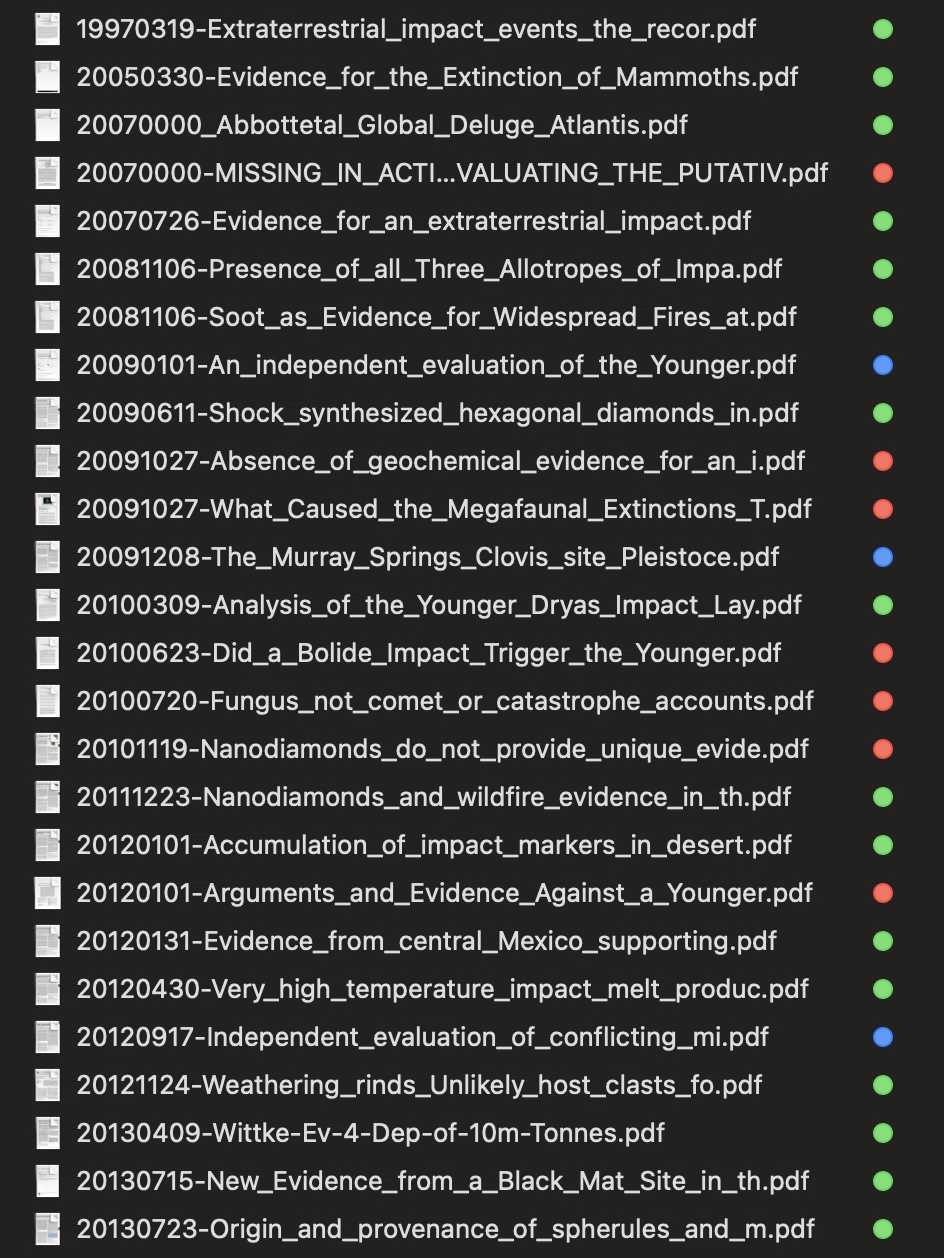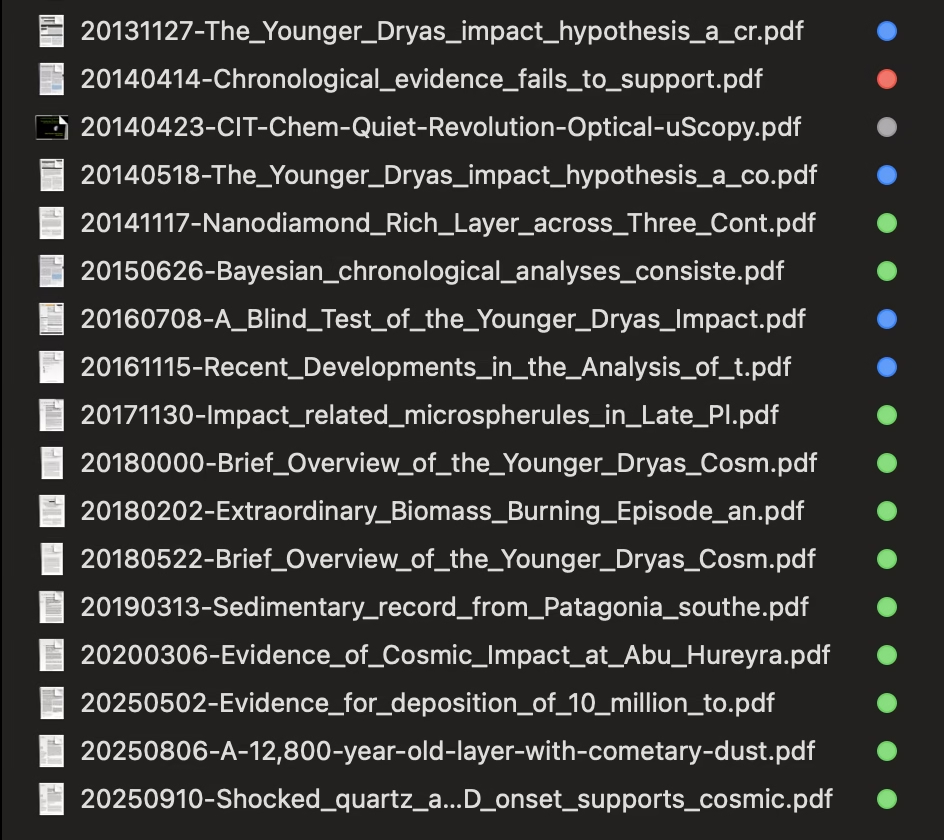Question: How do the geological and climatological records of the past 15,000 years correlate with myths and legends about global floods and “resets” of human civilization?
Several distinct impulses have been delivered to the global climate over the past 15,000 years.
- The Older Dryas impulse was delivered circa 14,000 years ago and lasted about 400 years.
- The Younger Dryas impulse was delivered circa 12,900 years ago and lasted about 1,200 years.
- The Younger Dryas meltwater Pulse 1B was delivered circa 11,400 years ago and lasted about 500 years.
- The Burckle object penetrated the Indian Ocean and the underlying seafloor an estimated 4,831 years ago, and together with suspected fragmentary impacts across the globe caused widespread, possibly global deluges lasting weeks to months.
Atlantis Revisited 4: Destruction
In Plato’s Atlantis (specifically in his Timaeus), the Egyptian astronomer priest Sonchis of Sais, speaking to the Athenian statesman Solon circa 600 BCE, calls “the extraordinary inundation” that destroyed Athens, apparently contemporaneously with the destruction of Atlantis, “the third before the Great Destruction of Deucalion”.
Atlantis Revisited 5: The Illustrated Plato’s Atlantis
The Burckle Crater at the bottom of the Indian Ocean is the remnant of what scientists believe to be an oceanic comet strike circa 5,000 years ago. After this and suspected additional concurrent fragment impacts vaporized and lofted millions of tons of seawater into the stratosphere, catastrophic and persistent deluges ensued over wide areas, possibly enveloping the entire world, but certainly the world known to the regional civilizations whose traditions preserved eyewitness accounts of this event. These traditions include the Mesopotamian Deluge of Gilgamesh, the Greek Deluge of Deucalion and the Hebrew Deluge of Noah.
Atlantis Revisited 6: The Waterspout of the Chaldeans
Native American tradition appears to have preserved a memory of the Burckle event, placing it at the destruction of their “Third World” and marking the onset of their “Fourth World” in which they (and all of us) live today. “Four days passed and then a great noise was heard all around the Third World. Begochiddy knew what it was, knew what was going to happen. Someone had done wrong. Now this Third World was about to be destroyed by flood.” — Bruchac, Joseph & Caduto, Michael J. “Four worlds: The Dine Story of Creation” Native American Stories. Golden, CO: Fulcrum Publishing, 1991.
The Atlantis Revisited documentary series at GoYrOwnWay.com covers this and more in illustrious detail.
Looking back over the 600 BCE report by Sonchis of Sais, we thus have:
- The Older Dryas commencing 14,000 years ago;
- The Younger Dryas commencing 12,900 years ago, contemporaneous with the disappearance of the Clovis culture in North America;
- The Younger Dryas meltwater pulse 1B commencing 11,400 years ago, contemporaneous with the Phaëthon mythos and the destruction of Atlantis, and with “the extraordinary inundation” of Athens, Greece, “which was the third before the Great Destruction of Deucalion”;
- The Burckle impact about 5,000 years ago, contemporaneous with
- the Deluge of the Chaldeans in Babylonian tradition,
- the Great Destruction of Deucalion in Greek mythology,
- the Hebrew Deluge of Noah in the Old Testament,
- the Deluge of Gilgamesh in Mesopotamian tradition,
- the destruction of the Third World in Native American tradition,
- the Deluge of the Popul Vuh, the Sacred Book of the Central Americans and
- an outbreak of the plague bacterium, Yersinia pestis, revealing that it ravaged Eurasia 5000 years ago.
There can be little doubt that this is what Sonchis of Sais was talking about circa 600 BCE when he told Solon of Athens that “there have been, and will be again, many destructions of mankind arising out of many causes“. What he could hardly have guessed was that these destruction events were most likely the results of major bolide strikes.
Atlantis Revisited 1: Interception
But wait! Sonchis DID guess this when he told Solon about the Greek Phaeton mythos he associated with the destruction of Atlantis, “Now this has the form of a myth, but really signifies a declination of the bodies moving in the heavens around the earth, and a great conflagration of things upon the earth which recurs after long intervals“. Right then and there, Sonchis told us straight up, in the clearest language available to him based on Egyptian records of eyewitness accounts from deep time (now mostly lost to history), that civilizations have been periodically reset by major bolide strikes, and it’s taken us 2,600 years to finally start taking him seriously.
The Official Story as of 21 October 2024:
“Atlantìs nêsos (lit. ’island of Atlas’) is a fictional island mentioned in Plato’s works Timaeus and Critias as part of an allegory on the hubris of nations.”
Strike that about taking Sonchis of Sais seriously — it’s taken us 2,600 years and counting.
Research Results as of 12 October 2025:
The following directory listing (in 2 parts) chronicles in order of publication date the papers at Academia.edu uploaded since 1997 that specifically address questions surrounding the Younger Dryas Impact Hypothesis (YDIH).


The color tags at the right of each entry encode the valence of the article as regards the Younger Dryas Impact Hypothesis (YDIH) as a legitimate causative accounting of the evidence found in the climatological and geological record:
- Papers tagged with green incline to favor the YDIH;
- Papers tagged with red incline against the YDIH;
- Papers tagged with blue are neutral on the YDIH;
- Papers tagged with gray are tangential to the YDIH;
The trend shows an ultimate inclination in favor of Younger Dryas Impact Hypothesis as a legitimate causative accounting of the evidence found in the climatological and geological record.
If we could put this question to nature, the universe or the Solar System and its surrounds, we know very well what an honest answer would look like: “I have no clue what I’m doing, let alone the ability to prevent celestial objects from hitting one another.” Supposing we were then to present to these natural forces the text of Genesis 8:21 in the Christian Bible, to wit (KJV) “And the LORD smelled a sweet savour; and the LORD said in his heart, I will not again curse the ground any more for man’s sake; for the imagination of man’s heart is evil from his youth; neither will I again smite any more every thing living, as I have done.” To this entreaty, by far the safest assumption is that there would be no reply, so that we don’t waste time waiting for one, or if a reply is stipulated, that it would be something like “You again? Asked and answered.“

